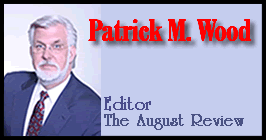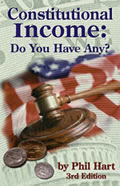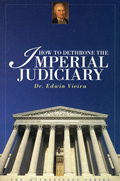Other
Wood
Articles:
Global Cities for Global Corporations
GLOBAL
BANKING: THE INTERNATIONAL MONETARY FUND
PART 1 of 3
Patrick
Wood
January 7, 2006
NewsWithViews.com
Note: This report is the second in a trilogy appearing in The August Review dealing with global banking as driven by the Bank for International Settlements, the IMF and the World Bank.
Introduction
The International Monetary Fund (IMF) is
a public institution, established with money provided by taxpayers around the world. This is important to remember because it does not report directly to either the citizens who finance it or those whose lives it affects. Rather, it reports to the ministries of finance and the central banks of the governments of the world.[1]
This authoritative statement comes from Joseph Stiglitz, who served for seven years as chairman of President Clinton's Council of Economic Advisers and as chief economist for the World Bank. Stiglitz is a mainstream globalist, but still honest enough to have become disillusioned with the corrupt practices of the IMF and the World Bank. His first-hand witness is very insightful:
International bureaucrats - the faceless symbols of the world economic order - are under attack everywhere. Formerly uneventful meetings of obscure technocrats discussing mundane subjects such as concessional loans and trade quotas have now become the scene of raging street battles and huge demonstrations... Virtually every major meeting of the International Monetary Fund, the World Bank, and the World Trade Organization is now the scene of conflict and turmoil.[2]
Why is the IMF an organization that people love to hate? This report will shed some light on the subject.
IMF Beginnings
According to its own literature, the IMF was "established to promote international monetary cooperation, exchange stability, and orderly exchange arrangements; to foster economic growth and high levels of employment; and to provide temporary financial assistance to countries to help ease balance of payments adjustment."
This innocuous description hardly describes the critical functions that the IMF provides to the process of globalization. Indeed, the IMF is one of the leading agents of change in the global economy and global governance.
The IMF was actually created in December, 1945 when the first 29 member nations signed its Articles of Agreement, and began operations on March 1, 1947. (Note: there are 184 member countries today.)
The authorization for the IMF came a few months earlier at the famous Bretton Woods conference of July 1944.
On the heels of World War II, the Bretton Woods Agreements established a system of procedures and rules, together with institutions to enforce them, that called for member countries to adopt a monetary policy that was fixed in terms of gold. Although the Bretton Woods system utterly collapsed in 1971 after President Nixon suspended convertibility of the dollar into gold, the institutions created in 1944 continued on uninterrupted.
While any country may become a member of the IMF, the road to membership is noteworthy. When application for membership is submitted to the IMF's executive board, a "Membership Resolution" is made to the Board of Governors that covers the member's quota, subscription and voting rights. If approved by the Board of Governors, the applicant must amend its own laws in order to permit it to sign the IMF's Articles of Agreement and to otherwise fulfill the obligations required of members. In other words, the member subordinates a certain part of its legal sovereignty to the IMF. This sets the stage for the IMF to take an active role in the affairs of the member country.
The IMF is viewed by some as a global organization, but it should be noted that the U.S. has 18.25 percent of the vote on the IMF board, or three times more than any other member. In addition, it is based in Washington, DC.
IMF Founders: Harry Dexter White and John Maynard Keynes
The principal architects of the Bretton Woods system, and hence the IMF, were Harry Dexter White and John Maynard Keynes.
 Keynes
was an English economist who has had an enormous impact on global
economic thinking despite the fact that many of his economic theories
have been thoroughly discredited. During WWII, he had called for the
dissolution of the Bank for International Settlements because of its
domination by Nazi operatives. After WWII however, when disbanding
the BIS was actually mandated by Congress, he argued against the dissolution
pending the creation of the IMF and World Bank. His latter argument
was the often and over-used rationale "If we close it down too
soon, the world financial system will collapse." Keynes globalist
instincts led him to call for a world currency, called Bancor, that
would be managed by a global central bank. This idea flatly failed.
Keynes
was an English economist who has had an enormous impact on global
economic thinking despite the fact that many of his economic theories
have been thoroughly discredited. During WWII, he had called for the
dissolution of the Bank for International Settlements because of its
domination by Nazi operatives. After WWII however, when disbanding
the BIS was actually mandated by Congress, he argued against the dissolution
pending the creation of the IMF and World Bank. His latter argument
was the often and over-used rationale "If we close it down too
soon, the world financial system will collapse." Keynes globalist
instincts led him to call for a world currency, called Bancor, that
would be managed by a global central bank. This idea flatly failed.
Harry Dexter White was also considered to be a brilliant economist, and was appointed in as 1942 assistant to Henry Morgenthau, Secretary of the Treasury. He remained Morgenthau's most trusted assistant throughout his term, and argued verbosely against the Bank for International Settlements. Like Morgenthau and most all Americans, White was strongly anti-Nazi. White, however, was NOT pro-American.[3]
On October 16, 1950, an FBI memo identified White as a Soviet spy whose code name was Jurist.
Following the collapse of the Soviet Union in 1991, formerly secret intelligence documents were made public and shined new light on the matter. White was not just a spy among the 50-odd identified American spies, he was likely the top spy for the USSR in the U.S.
In 1999, the Hoover Digest wrote:
In their new book Venona: Decoding Soviet Espionage in America, Harvey Klehr and John Haynes argue that of some fifty Americans known to have spied for Stalin (many more have never been identified), Harry Dexter White was probably the most important agent.[4]
Had White lived beyond 1946, he likely would have been prosecuted for high treason against the U.S., the penalty for which is execution.
Such is the moral fiber and intellectual credentials of the creators of the IMF: One was a English ideologue economist with a markedly global bent, and the other a corrupt and high-ranking U.S. government official who was a top Soviet spy.
Trying to figure out where these two really stood in the eyes of the core global elite has more twists than a Sherlock Holmes mystery story. It is more easily perceived by the end result -- the successful creation of the IMF and the World Bank, both of which were heartily endorsed by the likes of J.P. Morgan and Chase Bank, among other international bankers.
Positioning: IMF vs. the World Bank and the BIS
There is a triad of monetary powers that rule global money operations: the IMF, the World Bank and the Bank for International Settlements. Although they work together very closely, it is necessary to see which part each plays in the globalization process.
The International Monetary Fund (IMF) and the World Bank interact only with governments whereas the BIS interacts only with other central banks. The IMF loans money to national governments, and often these countries are in some kind of fiscal or monetary crisis. Furthermore, the IMF raises money by receiving "quota" contributions from its 184 member countries. Even though the member countries may borrow money to make their quota contributions, it is, in reality, all tax-payer money.[5]
The World Bank also lends money to governments and has 184 member countries. Within the World Bank are two separate entities, the International Bank for Reconstruction and Development (IBRD) and the International Development Association (IDA). The IBRD focuses on middle income and credit-worthy poor countries, while the IDA focuses on the poorest of nations. The World Bank is self-sufficient for internal operations, borrowing money by direct lending from banks and by floating bond issues, and then loaning this money through IBRD and IDA to troubled countries.[6]
The BIS, as central bank to the other central banks, facilitates the movement of money. They are well-known for issuing "bridge loans" to central banks in countries where IMF or World Bank money is pledged but has not yet been delivered. These bridge loans are then repaid by the respective governments when they receive the funds that had been promised by the IMF or World Bank.[7]
The IMF has become known as the "lender of last resort." When a country starts to crumble because of problems with trade deficits or excessive debt burdens, the IMF can step in and bail it out. If the country were a patient in a hospital, the treatment would include a transfusion and other life support measures to just keep the patient alive -- full recovery is not really in view, nor has it ever happened.
One must remember that rescue operations would not be necessary if it were not for the central banks, international banks, the IMF and the World Bank leading these countries into debts they cannot possibly ever repay in the first place.
The Purpose and Structure of the IMF
According to the IMF pamphlet, A Global Institution: The IMF's Role at a Glance,
The IMF is the central institution of the international monetary system—the system of international payments and exchange rates among national currencies that enables business to take place between countries.
It aims to prevent crises in the system by encouraging countries to adopt sound economic policies; it is also—as its name suggests—a fund that can be tapped by members needing temporary financing to address balance of payments problems.
The IMF works for global prosperity by promoting
-
the balanced expansion of world trade,
-
stability of exchange rates,
-
avoidance of competitive devaluations, and
-
orderly correction of balance of payments problems
The
IMF's statutory purposes include promoting the balanced
expansion of world trade, the stability of exchange rates, the avoidance
of competitive currency devaluations, and the orderly correction of
a country's balance of payments problems.[8]
[Note: Emphasis is theirs]
Although the IMF has changed in significant ways over the years, their
current literature makes it quite clear that the statutory purposes
of the IMF today are the same as when they were formulated in 1944:
i. To promote international monetary cooperation through a permanent institution which provides the machinery for consultation and collaboration on international monetary problems.
ii. To facilitate the expansion and balanced growth of international trade, and to contribute thereby to the promotion and maintenance of high levels of employment and real income and to the development of the productive resources of all members as primary objectives of economic policy.
iii. To promote exchange stability, to maintain orderly exchange arrangements among members, and to avoid competitive exchange depreciation.
iv. To assist in the establishment of a multilateral system of payments in respect of current transactions between members and in the elimination of foreign exchange restrictions which hamper the growth of world trade.
v. To give confidence to members by making the general resources of the Fund temporarily available to them under adequate safeguards, thus providing them with opportunity to correct maladjustments in their balance of payments without resorting to measures destructive of national or international prosperity.
vi. In accordance with the above, to shorten the duration and lessen the degree of disequilibrium in the international balances of payments of members.[8]
As lofty as this might sound, one can interpret meanings by matching up its actions. For instance, "consultation and collaboration" often means "we will enforce our policies on your country" and "adequate safeguards" mean the "collateral and concessions we demand in return for borrowing our money."
The IMF has been likened to an international credit union, where members who contribute reserves have the opportunity to borrow as the need may arise. The IMF is further able to raise funds by borrowing from member countries or from private markets. The IMF claims to have not raised funds from private markets as of yet.
This report will examine four aspects of IMF operations: Currency and monetary roles, moral hazard, bailout operations during currency crisis and conditionalities.
NEXT: Currency, Monetary Roles and Gold
Click here for part -----> 2 3,
Footnotes:
1,
Stiglitz, Globalization and its Discontents (Norton, 2002), p.12
2,
ibid, p. 3
3,
Ladd, FBI
Office Memorandum, October 16, 1950
4,
Beichman, Guilty
as Charged, Hoover Digest 1999 No. 2
5,
IMF web site, http://www.imf.org
6,
World Bank web site. http://www.WorldBank.org
7,
Baker, The Bank for International Settlements: Evolution and Evaluation,
(Quorum, 2002), p. 141-142
8,
IMF, What
is the International Monetary Fund?, 2004
� 2006 Patrick Wood -
All Rights Reserved
Patrick M. Wood is editor of The August Review, which builds on his original research with the late Dr. Antony C. Sutton, who was formerly a Senior Fellow at the Hoover Institution for War, Peace and Revolution at Stanford University. Their 1977-1982 newsletter, Trilateral Observer, was the original authoritative critique on the New International Economic Order spearheaded by members of the Trilateral Commission.
Their highly regarded two-volume book, Trilaterals Over Washington, became a standard reference on global elitism. Wood's ongoing work is to build a knowledge center that provides a comprehensive and scholarly source of information on globalism in all its related forms: political, economic and religious.
E-Mail: pwood@augustreview.com
Web Site: www.AugustReview.com
The IMF has become known as the "lender of last resort." When a country starts to crumble because of problems with trade deficits or excessive debt burdens, the IMF can step in and bail it out.












